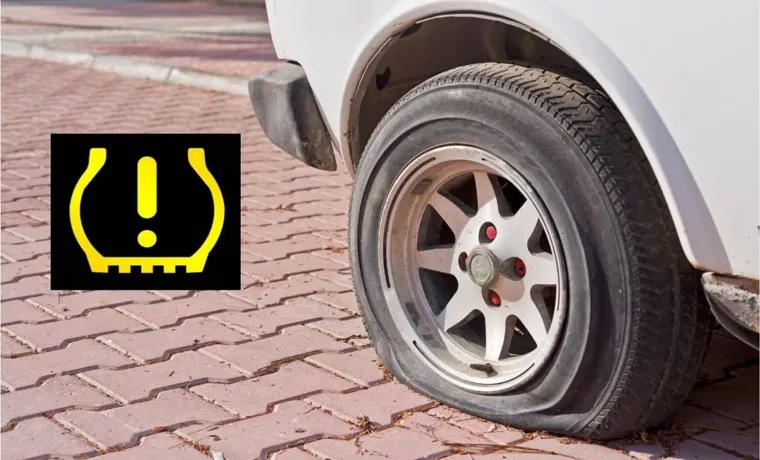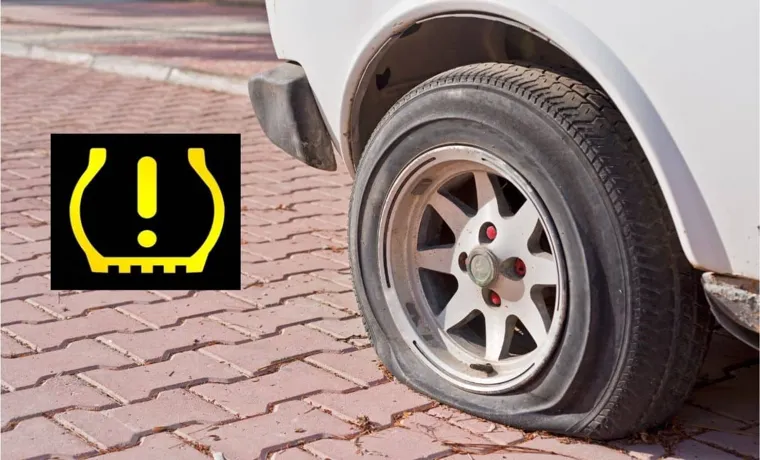Have you ever been driving when suddenly you see a blinking tire pressure light on your dashboard? It’s a common and often confusing experience for many drivers. But what does it mean? Is it something serious or just a minor issue? Well, the blinking tire pressure light is not something to be taken lightly. It’s a warning sign that something is wrong with the tire and needs immediate attention.
Think of it as your car’s way of waving a red flag to get your attention. In this blog post, we’ll take a closer look at what the blinking tire pressure light means and what you should do when you see it. So sit tight and buckle up!
Table of Contents
Understanding Your Tire Pressure Monitoring System (TPMS)
If the tire pressure light on your car blinks, it means that there is a problem with your TPMS. This system monitors the pressure levels in your tires and alerts you if they are underinflated, which could lead to a dangerous blowout while driving. When the light stays on, which is different from blinking, it means that at least one of your tires is significantly below the recommended pressure level.
In this case, you should immediately check your tire pressure to ensure that they are properly inflated. If the light is still blinking after you have checked your tire pressure, it could mean that there is a malfunction in the TPMS system itself. It’s important to have this issue resolved as soon as possible to ensure your safety on the road.
Remember, your TPMS is a vital component of your car’s overall safety system, so be sure to take care of it and address any issues that arise promptly.
What is TPMS?
TPMS Do you know that the tire pressure monitoring system (TPMS) is an essential safety feature in your car? The TPMS is an electronic system that monitors the air pressure in your tires and alerts you when the pressure drops below a certain level. This helps you avoid serious accidents that can occur due to underinflated or overinflated tires. The TPMS sensors are located inside each tire and transmit data to the car’s computer.
The computer then analyzes the data and alerts you through a warning light on your dashboard if there is a problem. Properly inflated tires are not only important for your safety but also improve your fuel economy and extend the life of your tires. It’s essential to ensure your TPMS is functioning correctly and have your tire pressure checked regularly to keep you and your car safe on the road.
So, next time you see the TPMS warning light on your dashboard, don’t ignore it!

Why is TPMS important?
TPMS Understanding your tire pressure monitoring system (TPMS) is essential for ensuring your safety on the road. TPMS helps you monitor your tire pressure in real-time, and alerts you when it falls below the recommended levels. This is crucial, as underinflated tires can lead to decreased fuel efficiency, tire blowouts, and increased risk of accidents.
Additionally, over-inflation can also be harmful to your tires. With TPMS, you can easily keep your tires at the optimal pressure, ensuring your safety and prolonging the life of your tires. So, whether you’re a new driver or an experienced one, it’s always important to pay attention to your TPMS and keep your tires properly inflated.
With regular maintenance, you can avoid expensive repairs, improve your gas mileage, and have peace of mind while on the road. Make sure to check your TPMS regularly and have it serviced by a professional if necessary.
How does TPMS work?
If you’ve ever wondered how your car knows when your tire pressure is low, that’s thanks to your Tire Pressure Monitoring System (TPMS). This system is a safety feature that uses sensors to measure the air pressure in your tires. When your tire pressure drops below a certain level, your TPMS sends a signal to your car’s computer, which then alerts you with a warning light on your dashboard.
This warning light lets you know that you need to check your tire pressure and make sure that it’s at the proper level. The TPMS system can help you avoid potentially dangerous situations, such as blowouts or accidents, and can even help improve your fuel efficiency by ensuring that your tires are properly inflated. So, if you see that warning light come on, don’t ignore it – take the time to check your tire pressure and keep yourself and your passengers safe on the road.
Possible Reasons for Blinking Tire Pressure Light
Have you ever been driving down the road and suddenly noticed your tire pressure light blinking? If so, you’re not alone. A blinking tire pressure light can be a cause for concern and may indicate an issue with your tires. One possible reason for a blinking tire pressure light is that your tire pressure is critically low.
This can be dangerous as it can lead to a blowout or other tire-related issues. Another reason could be a malfunction with the tire pressure monitoring system itself. It’s important to get your vehicle checked by a mechanic as soon as possible to determine the root cause of the blinking light and prevent any further issues.
Remember, maintaining proper tire inflation is crucial for the safety and longevity of your vehicle’s tires and can also improve fuel efficiency. So if you notice your tire pressure light blinking, don’t ignore it – take action and get it resolved.
Low Tire Pressure
Low tire pressure is one of the most common reasons why a tire pressure light might start blinking on the dashboard of your car. If this happens, some of the possible reasons for the low pressure could be a punctured tire, a damaged valve stem, or a leaky air hose. It’s important to check the tires to see if any are visibly flat or if the tread looks damaged.
It’s also good to verify that the pressure in your tires is at the correct level, which can be found in your car’s manual. If the low pressure persists, it could be a sign of a larger issue, like a problem with the tire pressure monitoring system. If that’s the case, it’s important to get the car checked by a mechanic to avoid any potential safety issues while driving.
Remember to keep an eye on your tire pressure and check it regularly to avoid any unexpected surprises while on the road.
Faulty TPMS Sensor
If you see your tire pressure light blinking, it could be due to a faulty TPMS sensor. The TPMS (Tire Pressure Monitoring System) sensor is designed to alert you when the pressure in your tires is low, but if the sensor is malfunctioning, it can lead to false alarms. This can be frustrating for drivers who may constantly be checking their tire pressure, only to find that everything is normal.
The TPMS sensor can malfunction due to a variety of reasons, such as a dead battery or a faulty sensor component. It’s important to get this issue checked out by a mechanic, as driving with a faulty TPMS sensor can be dangerous. You may not be aware if your tire pressure is actually low, which can lead to a blowout or other serious tire-related issue.
To avoid this issue, make sure to have your TPMS sensor checked regularly and replace it if necessary. It’s always better to be safe than sorry when it comes to your tires, as they are a critical component of your vehicle’s safety. So, if you notice your tire pressure light blinking, don’t ignore it – get it looked at by a professional to ensure your safety on the road.
Electrical System Malfunction
If you’ve noticed your tire pressure light blinking on your dashboard, it may be an indication of an electrical system malfunction. There are a few reasons this may be happening. One possible reason is a faulty tire pressure monitoring system (TPMS) sensor.
This sensor constantly monitors the tire pressure and sends signals to the car’s computer system. If the sensor is faulty, it might send inaccurate signals, making the light blink. Another possible reason is a weak battery.
The TPMS sensor requires a certain amount of power to function properly. If the battery is weak, it might not be able to provide the necessary power, and the sensor won’t function properly. A third possible reason is a malfunctioning TPMS module.
This module is responsible for interpreting the signals from the TPMS sensor and alerting the driver if the tire pressure is too low. If the module is malfunctioning, it might not alert the driver properly, causing the tire pressure light to blink. It’s best to have a professional mechanic diagnose the issue and fix it promptly to ensure your safety on the road.
What to Do When the Tire Pressure Light Blinks
Have you ever been driving and suddenly noticed that your tire pressure light is blinking? The blinking tire pressure light indicates that there is an issue with your tire pressure monitoring system, also known as TPMS. It could be due to a variety of reasons, like a malfunctioning sensor or a tire that has low or high pressure. When you spot a blinking tire pressure light, it’s important to take action to prevent any potential accidents or damages.
First, pull over to a safe location and check your tire pressures with a tire gauge. If any tire has low pressure, try inflating it to the recommended PSI level stated in your vehicle owner’s manual. If you are unable to fix the issue on your own, it’s best to reach out to a trusted mechanic for assistance.
By addressing the cause of the blinking tire pressure light, you’ll be able to ensure that your vehicle runs smoothly and safely.
Check Your Tires for Signs of Damage or Punctures
If you’ve ever had your tire pressure light blink, you know it can be a bit unsettling. However, it’s essential not to panic and assess the situation. One of the first things you should do is check your tires for signs of damage or punctures.
Look for any foreign objects like nails or screws that may be lodged in your tire. If you find anything, do not attempt to remove it yourself. Instead, take your vehicle to a professional mechanic who can inspect and repair the tire for you.
If you don’t see any visible punctures, then the issue could be low tire pressure. Check the recommended tire pressure for your vehicle, and inflate the tires accordingly. Overinflating or underinflating your tires can lead to premature wear and tear and potential blowouts, so it’s crucial to maintain the proper pressure.
In conclusion, it’s essential to check your tires for damage or punctures when your tire pressure light blinks. Keep your tires properly inflated, and address any issues promptly to ensure safe driving.
Check Your Tire Pressure with a Gauge
Have you ever been driving along and suddenly noticed your tire pressure light blinking on your dashboard? It’s a common occurrence, but it’s essential to address it as soon as possible to avoid any risks of accidents or damage to your vehicle. The first step is to check your tire pressure with a gauge. A tire gauge is a handy tool that measures the air pressure inside your tires.
You can purchase them at any auto supply store or find them online. Once you have a gauge, remove the cap from the valve stem on your tire, attach the gauge, and read the pressure. If it’s not in the recommended range, add air until it is.
If you’re unsure of what pressure your tires should be, refer to your vehicle’s owner manual or check the label inside the driver’s door. Remember to check your tire pressure at least once a month and before any long road trips. Proper tire inflation not only improves your vehicle’s fuel efficiency but also extends the life of your tires.
Don’t forget, staying on top of tire maintenance can prevent any potential issues and keep you driving safely on the road!
Reset the TPMS System
If you’re driving down the road and suddenly see the tire pressure light blinking on your dashboard, don’t panic. It’s a common issue that can be easily fixed by resetting your TPMS system. This happens when your tire pressure drops below the recommended level, and the sensors in your wheels trigger the warning light.
To fix this, start by checking your tire pressure with a gauge, and add air as needed. Once your tires are inflated to the recommended level, you can reset the TPMS system by following a few simple steps. Look in your car manual to see the exact procedure for your specific make and model, but it usually involves turning the car on and off, pressing a button, or driving at a certain speed for a few minutes.
By resetting your TPMS system, you’ll be able to avoid any potential safety hazards on the road and keep your tires in top condition. So next time that tire pressure light blinks, relax and remember that it’s an easy fix with just a few steps.
Conclusion
In conclusion, when your tire pressure light blinks, it’s like your car’s way of saying “Hey buddy, you might wanna check on your tires before we have a blowout and things get real bumpy.” So don’t ignore that little blinking light, because keeping your tires properly inflated not only keeps you safe but also improves your fuel efficiency. And who doesn’t love saving some gas money? So stay alert, keep your tires in check, and let that flashy little light remind you to always keep things rolling smoothly.
“
FAQs
What does it mean when a tire pressure light blinks?
A blinking tire pressure light typically indicates that your tire pressure is critically low and needs immediate attention.
How do I check my tire pressure?
You can check your tire pressure using a tire pressure gauge, which measures the air pressure in your tires. Alternatively, many newer cars come equipped with tire pressure sensors that can display the pressure directly on the dashboard.
What is the recommended tire pressure for my car?
The recommended tire pressure for your car is typically found in the owner’s manual or on a sticker located on the driver’s side door jamb. The recommended pressure can also vary depending on the type of tires on your car.
Can I drive with a blinking tire pressure light?
It is not recommended to drive with a blinking tire pressure light as it could indicate a dangerous situation with your tires. You should pull over and check your tire pressure as soon as possible.
How often should I check my tire pressure?
You should check your tire pressure at least once a month, and always before embarking on a long road trip. Changes in weather and temperature can affect tire pressure, so be sure to check it frequently.
Do I need to inflate my tires to the maximum pressure listed on the tire sidewall?
No, you should inflate your tires to the recommended pressure listed in your owner’s manual or on the driver’s side door jamb. The maximum pressure listed on the tire sidewall is the maximum safe pressure for the tire, but may not be the best pressure for your particular vehicle.
Can overinflating or underinflating my tires have negative effects on my car?
Yes, overinflating or underinflating your tires can lead to poor handling, accelerated tire wear, and reduced fuel efficiency. Maintaining the correct tire pressure is important for both safety and performance.



